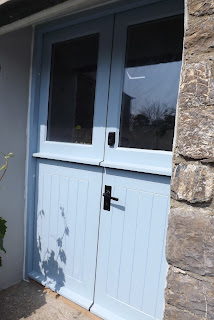Only two more to go.
I sense a running theme for this January. It's all just lion, lions, lions. Lion posts, lion doors and when we were fitting windows at Furzeleigh Mill today, we looked up and lo and behold; cast iron lion gutters!
Not something you see every day (in fact never). The windows went in well, no doubt helped by the lion gods looking down.
Clearly, they wanted to give me time to get on with their friend's door.
Whether it's fitting windows or carving, it's good to take pride in your work.
The livery cup-board's upper level has a cupboard with canted sides, made up of framing, a door and two panels. The door and panels have the same design, the panels being a bit bigger than the door, to allow for them being held in grooves in the frame.
All three have a raised section in the form of a lion, so in selecting stock for this, I am looking for a piece of oak that can accomodate this.
For the benefit of anyone reading this blog for the first time, I convert logs by splitting them in half, and then half again, and so on, leaving 'pieces of cake', from which I then extract the required 2x4, 2x1, or whatever.
This 'piece of cake' was riven some years ago. It is ideal for my needs, having a bump on the side.
I might get the door and one panel from it.
After isolating the raised area with a saw, I removed the waste with the side axe. I found a framing chisel quite useful for flattening the door around the central block.
After working out the actual shape of the lion's head, back to the saw, and then in with gouges.
So the s-scroll from the last post belongs to the top rail for a livery cupboard. In Tudor times (16th century), in England, livery cupboards were used for the storage and distribution of food (livery) and probably the equipment for doling it out. The more extravagant pieces were status symbols, and possibly also used to display the best silver.
The livery cupboard I am making is based on a high-end example and will be extensively carved to reflect this. It will have tudor roses, lion posts and cockatrices/basilisks as per the original.
Livery cupboards from the earlier part of this period often have lions or mythological creatures as the corner posts and that is the case with this one. Later examples tended towards simpler turned posts.
The lion posts here have been taken to an almost finished stage. They are still a bit green and I will finish them completely once they have dried. I haven't finished the feet as I may need to adjust them when I assemble the cupboard; they need to line up with the corner of the middle shelf, all will become clear later.
The s-scroll rail which will go above the lion and shield posts, has scrolls over and beyond any I have carved before; they extend and interweave. Here is the whole rail, with the ground on most of it still to remove.
The middle shelf has a drawer below it, and what a drawer! It will have a running cockatrice design. Cockatrices were a mythological creature popular in Tudor times. A mix of cockerel, lion and reptile, you wouldn't want to bump into one on a dark night.
The side rails adjacent to the s-scroll rails and the drawer front are continuations of these designs, but there are lots of other unusual carvings, which make up the rest of this piece, to come.
I thought I was about to get stuck into making a riven chest, and then I got the go-ahead for several listed building jobs. Windows and doors, architectural joinery restoration. So last year was mostly taken up with those.
Continuuing work on this Dartmoor house, the original parts of, being 15th century. Some new windows, sliding sash restoration, a new porch, new barge boards etc.
Some double stable doors and windows to replace the modern units on this 14th century farmhouse in Broadhempston.
